Cherry barb (Puntius titteya) is a small and nice aquarium fish, one of the most popular barb species. Cherry Barbs are generally peaceful and active fish, making them suitable for beginner and experienced aquarists alike. Further in the article, you’ll find out how to keep cherry barb, feed it, select tank mates, and breed it.
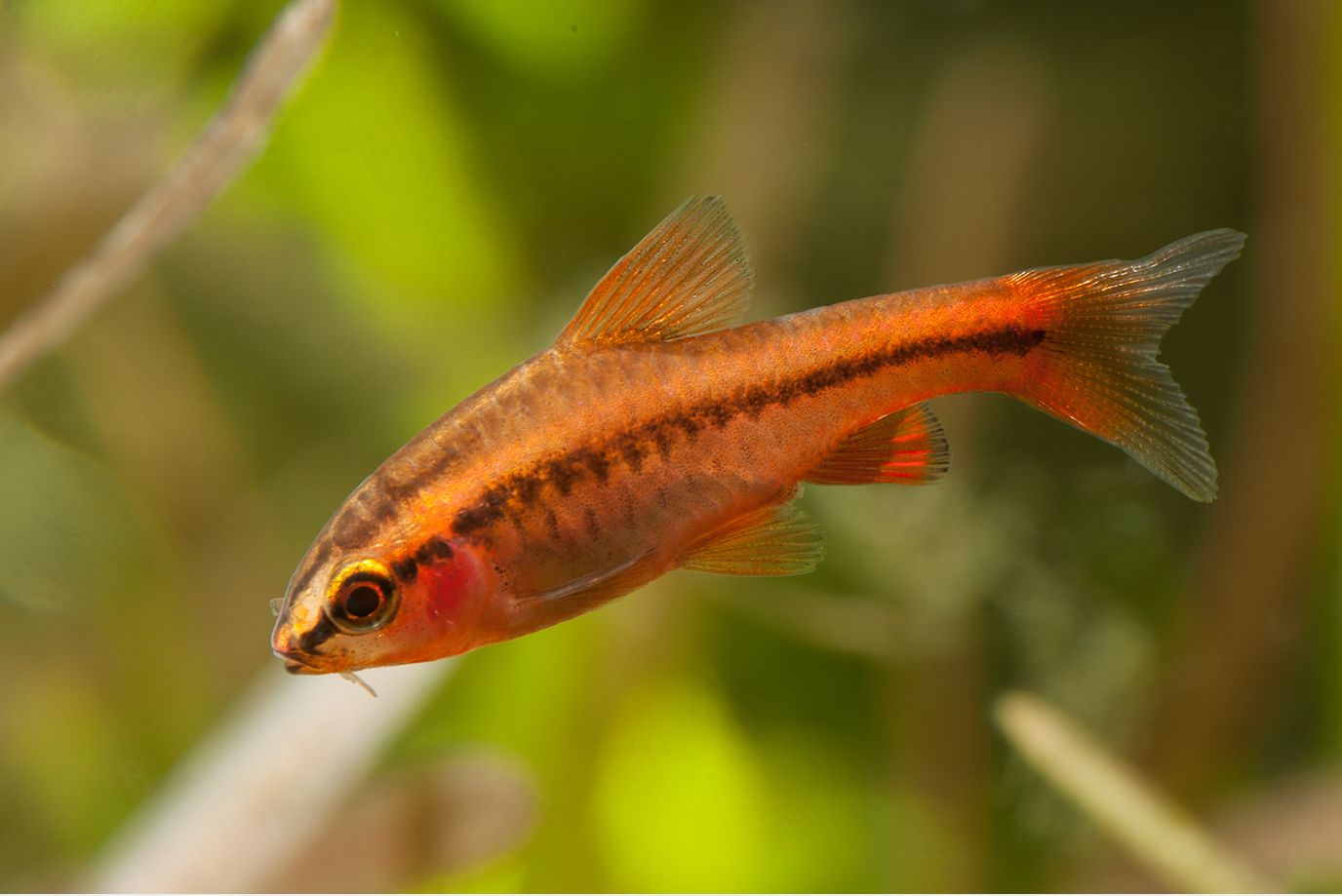
Contents
Habitat in the wild
The cherry barb is native to freshwater ponds of Sri Lanka South-West areas – Kelani and Nilwala river-valleys, where they live in shadowed soundings of streams and small rivers with muddy bottom, which has large amount of plant matter and small drain system between them. Some shallow pristine streams with transparent or a bit colored water are cherry barb habitats.
In their natural habitat, these fish inhabit slow-moving and heavily vegetated waters, including areas with dense plant growth and leaf litter. They prefer habitats with a moderate to strong water flow and are often found in areas with plenty of hiding spots such as submerged roots and vegetation.
Through thick three cover very few light reaches the water surface, that’s why water plans are shadowed. Water temperature in these streams varies from 23 °C to 27 °C, dH: 5 — 19, and pH: 6.0 — 7.5.
As a rule the pond bottom is sandy with a layer of sunken leaves and tree brunches. Nowadays export of wild species from Sri Lanka is prohibited, though the fish capture obviously continues. According to reports, the number of brightly colored barbs in the natural population decreases day by day. This is caused by selective capture of brightly colored species.
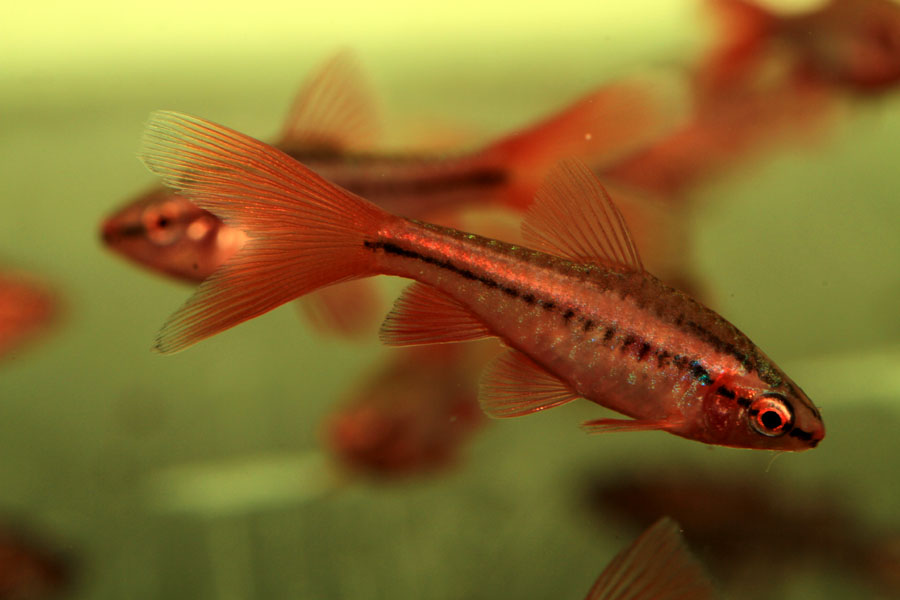
Description
It has elongated body, its back profile is rather curved, and lateral line isn’t complete. The fish has inferior mouth and one pair of barbs. Male has brown-green back and reddish or body bottom which is separated from the body sides with brown-red lateral line. The fish iris is bloody-red on top. Female abdomen is whitish, the back is yellow-gray and lateral line is also brown-red. The fins color varies from yellowish to red.
Albino cherry barb
In captivity you may encounter albino cherry barbs species. The Albino Cherry Barb is a variant of the Cherry Barb (Puntius titteya) that displays a white or pale pinkish body coloration due to a genetic mutation. This variety lacks the typical pigmentation found in the original cherry barb, resulting in its distinctive appearance. The care requirements and general characteristics of Albino Cherry Barbs are quite similar to their non-albino counterparts.
Longfin or veiltail cherry barb
Is a selectively bred variant of the cherry barb. It is characterized by its long, flowing fins, which give it a more elegant and graceful appearance compared to the standard cherry barb. The care requirements and general characteristics of longfin Cherry Barbs are quite similar to their shortfin counterparts.
Size
How big do cherry barbs get?
Cherry barb body size of around 1.5 to 2 inches (3.8 to 5 centimeters) in length, it’s a small fish. Males tend to be slightly smaller and more slender than females. It’s important to note that individual fish sizes can vary, and factors such as genetics, diet, and overall health can influence their growth.
Lifespan
How long do cherry barbs live?
Lifespan in captivity is about 4-5 years. However, with proper care and optimal tank conditions, some individuals have been known to live up to 6 years or even longer. Providing a well-maintained aquarium with suitable water parameters, a balanced diet, and a stress-free environment can contribute to their longevity.
| Characteristic | Description |
|---|---|
| Scientific Name | Puntius titteya |
| Common Name | Cherry Barb |
| Native Habitat | Sri Lanka, rivers and streams |
| Size | 1.5 to 2 inches (3.8 to 5 centimeters) |
| Body Color | Males: reddish-brown body with red fins and black dorsal spot; Females: silvery |
| Lifespan | 3 to 5 years (up to 76 years with proper care) |
| Tank Size | Minimum 10 gallons |
| Water Temperature | 72°F to 79°F (22°C to 26°C) |
| Water pH | 6.0 to 7.5 |
| Compatibility | Peaceful, suitable for community aquariums |
| Diet | Omnivorous, flake or pellet food, supplemented with live or frozen foods |
| Behavior | Peaceful, active swimmers, schooling behavior |
| Breeding | Separate breeding tank, spawning medium or plants, slightly softer and more acidic water conditions |
Difficulties in keeping
Temper is rather peaceful and the fish isn’t demanding itself, so it does well with all peaceful fishes. However, the cherry barb requires well-kept tank with stable water parameters and clean water. If this is about your tank, than there should be no problem with keeping.
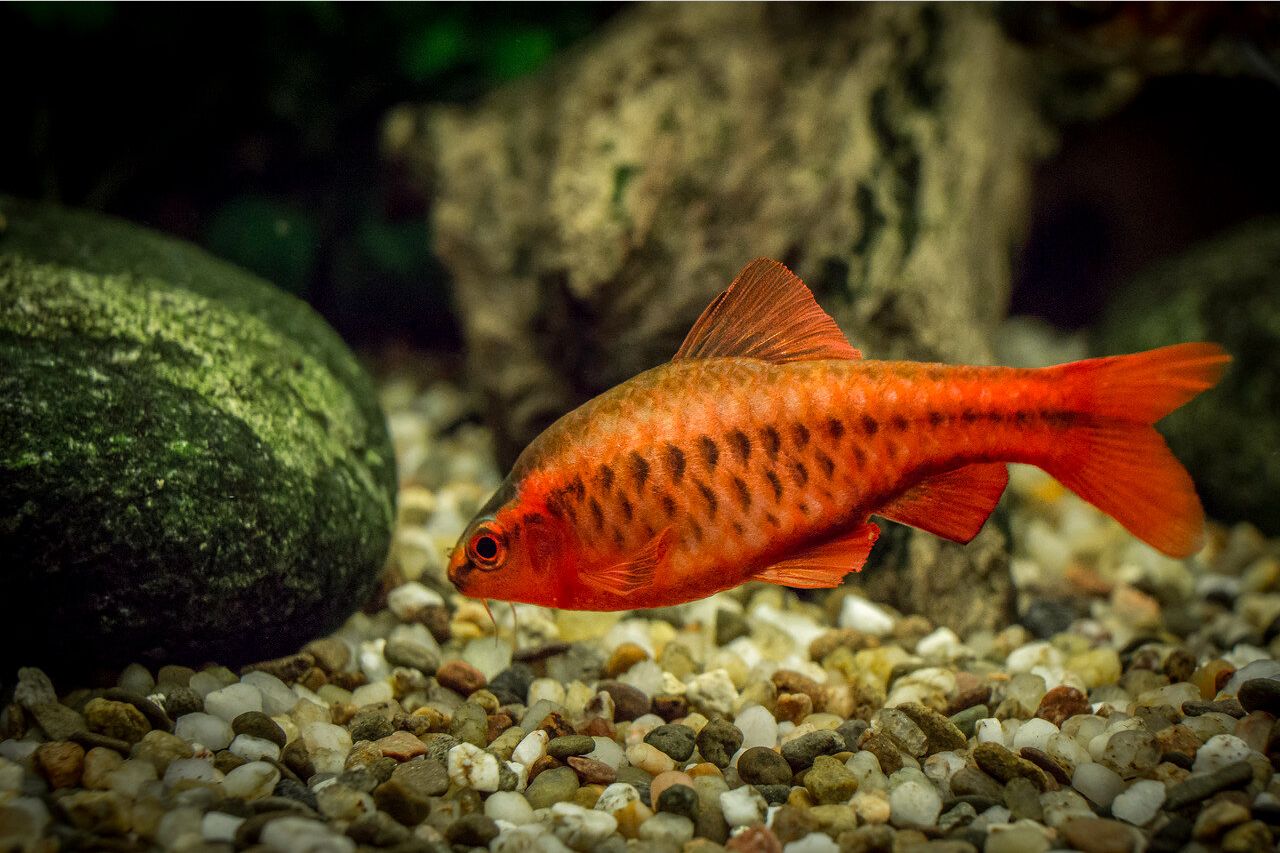
Care and keeping in a tank
Tank size
Are cherry barbs schooling fish?
Yes, cherry barb is a schooling fish, so it’s desirable to keep about 6-10 species in a tank. This reduces the stress and makes it less timid. Besides, the male demonstrates brighter coloring in the presence of rivals. Recommended minimum tank volume is 10 gallons (37.8 liters), this tank size provides enough space for a small group of cherry barbs to swim and thrive comfortably. However, it’s important to consider that larger tanks offer more stability and provide additional swimming space for the fish.
If you plan to keep a larger group or include other fish species in the same aquarium, a larger tank is advisable. Providing ample swimming space and territory for the fish can help reduce stress and minimize aggression within the tank. Remember to consider the dimensions of the tank as well. Cherry barbs are active swimmers, so a longer tank with more horizontal swimming space is preferable over a tall, narrow tank.
You should ensure good water filtration and some slow water flow in the tank.
Tank decor
Choice of tank decorations isn’t a crucial factor, although cherry barb becomes brighter in a thickly planted tank with dark bottom substrate. It’s desirable to add some fluctuant and snags into the tank. The tank should be thickly planted since cherry barb is rather timid fish and they need a possibility to hide in the plants. However, you should leave some free, not planted area in the tank, where the fish can swim. As a rule the cherry barb swims in the middle and bottom water layers.
As we’ve already mentioned, tank mates should be peaceful, since this one is a peaceful, too.
Water parameters
Cherry barbs have relatively adaptable water parameter requirements, but it’s important to maintain suitable conditions to ensure their well-being. Here are the recommended water parameters:
- Temperature: Ideally, the water temperature should be maintained between 72°F and 79°F (22°C to 26°C). This range closely mimics their natural habitat in Sri Lanka.
- pH Level: Cherry Barbs prefer a slightly acidic to neutral pH range of 6.0 to 7.5. Aim to keep the pH stable within this range to provide a suitable environment for them.
- Water Hardness: They can tolerate a range of water hardness levels, but it’s best to keep the water on the slightly softer side. Aim for a general hardness (GH) of 5 to 12 degrees and a carbonate hardness (KH) of 2 to 8 degrees.
- Ammonia, Nitrite, and Nitrate Levels: It’s important to regularly test and maintain low levels of ammonia, nitrite, and nitrate in the aquarium. Ammonia and nitrite should ideally be undetectable, while nitrate should be kept below 20 parts per million (ppm).
Filtration
To achieve and maintain these water parameters, proper filtration and regular water changes are essential. Using a good-quality filter will help remove waste and maintain water quality. Regularly testing the water parameters with a reliable test kit will allow you to monitor and adjust them as needed.
Tank mates
Cherry barbs are generally peaceful and can coexist with a variety of other peaceful fish species in a community aquarium. Unlike lots of its relatives cherry barb behavior is very peaceful and calm. They don’t even touch long finned fishes.
It’s an ideal fish for community tanks, but it has to be kept with fishes of the same small size. Small and helpless cherry barb will be an easy prey for any predator fish. For example, angelfish is rather large and aggressive tank mate. However, cherry barb won’t attack them, but they may do this. It’s good to keep it with tetras. Cherry barb is also tolerant towards any shrimps, even so small as cherry shrimp.
Here are some popular tank mates that can be suitable companions for cherry barbs:
- Harlequin Rasboras (Trigonostigma heteromorpha)
- Neon Tetras (Paracheirodon innesi)
- Ember Tetras (Hyphessobrycon amandae)
- Glowlight Tetras (Hemigrammus erythrozonus)
- Black Neon Tetras (Hyphessobrycon herbertaxelrodi)
- Cardinal Tetras (Paracheirodon axelrodi)
- Rummy Nose Tetras (Hemigrammus rhodostomus)
- Dwarf Gouramis (Trichogaster lalius or Trichogaster chuna)
- Sparkling Gouramis (Trichopsis pumila)
- Celestial Pearl Danios (Danio margaritatus)
- White Cloud Mountain Minnows (Tanichthys albonubes)
- Dwarf Rasboras (Boraras spp.)
- Endler’s Livebearers (Poecilia wingei)
- Guppies (Poecilia reticulata)
- Platies (Xiphophorus spp.)
- Corydoras Catfish (Corydoras spp. – pygmy cory, panda cory, adolfoi catfish)
- Otocinclus Catfish (Otocinclus spp.)
- Bristlenose Plecos (Ancistrus spp.)

Diet
The cherry barb isn’t demanding, so it eats all types of feed, but you have to keep in mind that the fish is small and it won’t be able to swallow large grained food.
A staple diet of high-quality flake or pellet food specifically formulated for tropical fish is suitable for cherry barbs. Choose a reputable brand that provides a balanced combination of protein, vitamins, and minerals. Supplementing their diet with live or frozen foods is beneficial. Cherry Barbs enjoy small live or frozen foods such as brine shrimp, bloodworms, daphnia, and mosquito larvae.
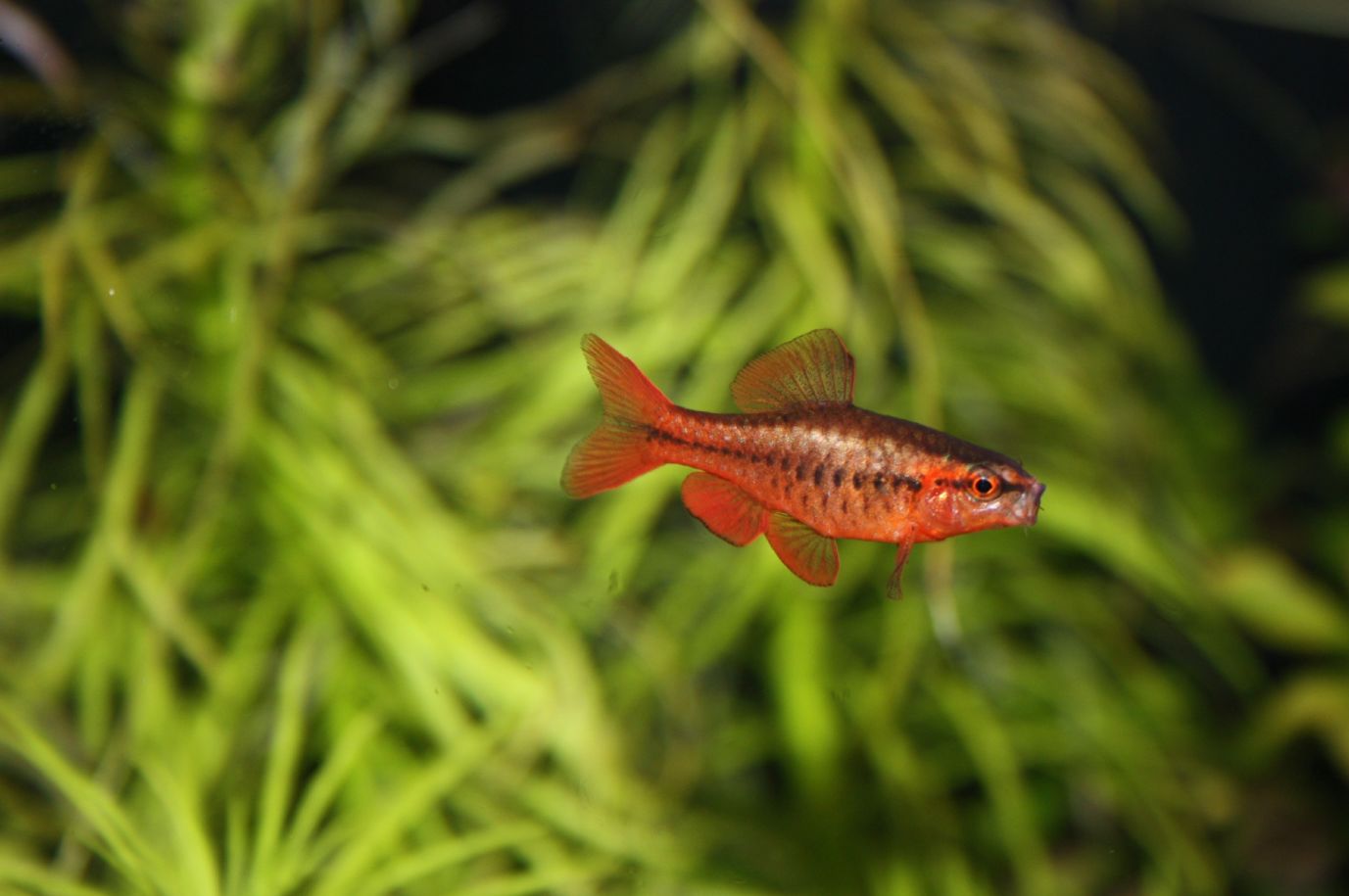
Gender differences: male vs female
When cherry barb is young it’s difficult to see between the male and female. However, when the fish becomes reproductive the differences become more visible: the female is fatter with rounded abdomen while the male is slim and brighter colored. Male cherry barbs display more vibrant coloration than females, especially during the breeding season or when they are trying to court females.
Also male have their so called fights, without any fight actually, but demonstrating their best colors. Males often exhibit more active and aggressive behavior, especially when establishing dominance or courting females.
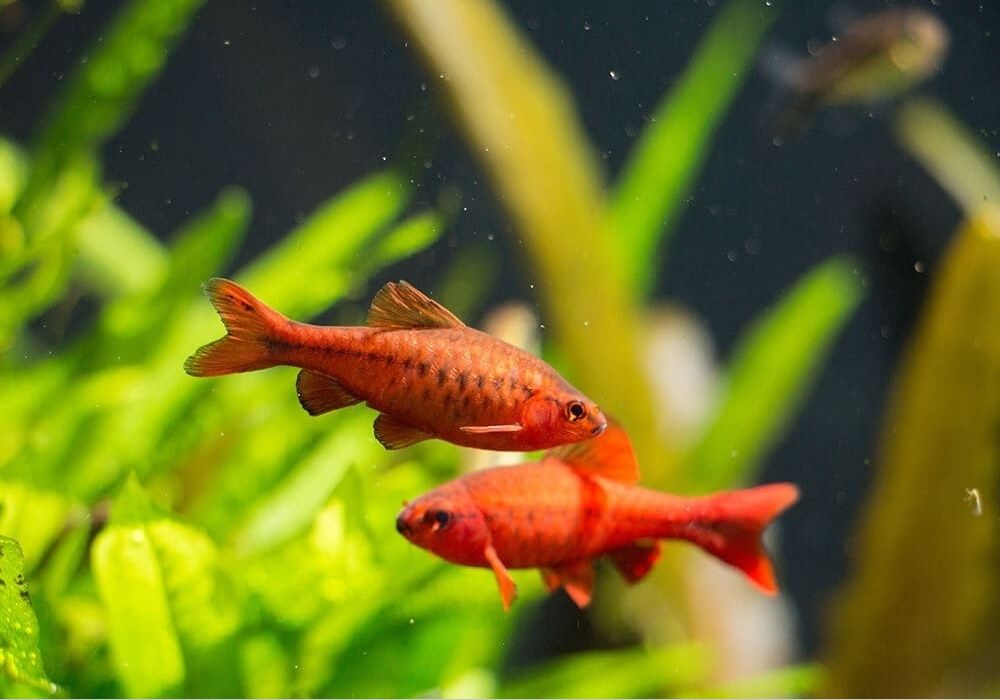
Breeding
As spawning tank you may use a small volume 20-25 cm (8-10 in) long with small amount of water, which temperature is 26-28 °C (78-82 °F).
Tank plants presence is a must. First put the cherry barb males and females apart for 7-10 days and feed them well. You may also renew some part of the tank water and rise its temperature a bit. Optimal ratio of the males and females in the tank is 2:1.
After spawning (usually in the morning) the tank with eggs should be shadowed and the fish are removed from the tank. Incubation period for the eggs is 36-48 hours. The larva becomes a juvenile 2-3 days later. When being a juvenile the fish becomes 1.2-1.8 cm long, this period lasts for 45-60 days.